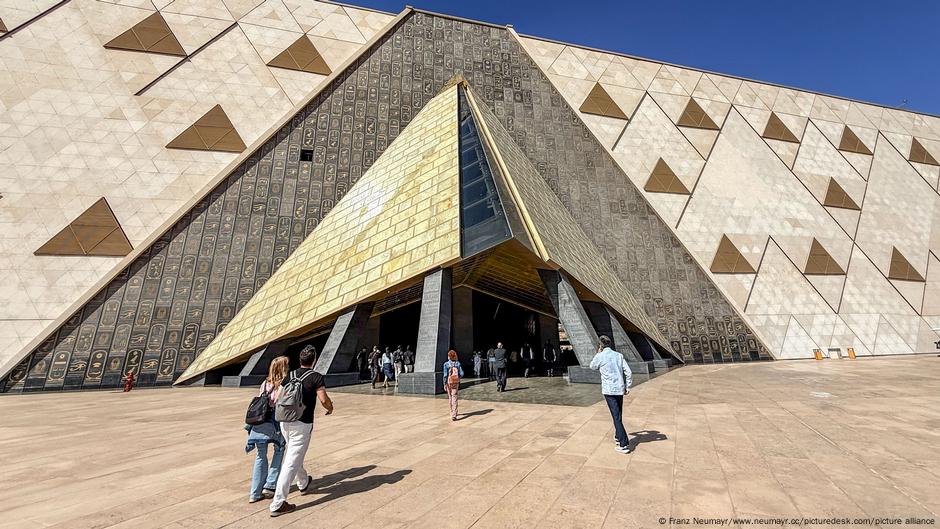Just outside , right next to the famous Pyramids of Giza, a monumental facade of glass and light sandstone rises from the desert. Behind this nearly one-kilometer-long facade, a true homage to history has been created. most ambitious cultural project, the Grand Egyptian Museum (GEM), has been completed and is now celebrating its full opening — after years of delay.
Designed by Irish firm Heneghan Peng Architects, the imposing building near Cairo covers around 500,000 square meters — equivalent to about 70 soccer fields. It has enough space for over 100,000 artifacts representing seven millennia of Egyptian history, including Pharaonic, .
The highlight of the permanent exhibition is the complete collection of , which includes more than 5,000 artifacts and the legendary golden funerary mask. Also included in the collection is the 42-meter-long and over 4,000-year-old funerary , also known as the Cheops ship.
The main galleries contain various thematic sections related to royalty, society and religion. The centerpieces of the museum are an imposing staircase that extends across all floors and an atrium with an 11-meter-high statue of seated on his throne.
A mammoth project decades in the making
In the planning stages since the early 2000s, construction was delayed several times. The reasons included the and political tensions in the Middle East. Since October 2024, the museum has been in its “soft opening” phase, with visitors able to view selected areas and book special tours.
Now the opening of the entire museum is approaching, and Egypt’s Prime Minister Mostafa Madbouly hopes that numerous international heads of state and government will attend the opening ceremony on November 1. It will be “a night to remember,” promised Egypt’s Minister of Tourism and Antiquities Sherif Fathy in The National, an English-language magazine from Abu Dhabi. The guest list of international celebrities from politics, culture and showbiz is long. German has announced his attendance.
The opening will feature a magnificent torchlight procession, during which the famous finds from Tutankhamun’s tomb will be transported from the old museum on Cairo’s Tahrir Square to the new museum.
The world of the pharaohs
What makes the exhibition special is that it breaks with old forms of presentation. “In the past, artifacts from the Old, Middle or New Kingdoms were displayed separately,” explained archaeologist Magdi Shakir in the Turkish daily newspaper Daily Sabah. “Now, each theme is presented in a panoramic narrative. Each object in the Grand Egyptian Museum follows a unique curatorial story, offering a fresh perspective even on familiar pieces — making it an unprecedented experience.”
The new concept aims to give visitors an understanding of the bigger picture rather than of individual objects — power, everyday life and beliefs are narrated across dynasties.
Culture and identity in the 21st century
Prime Minister Mostafa Madbouly confirmed in the Egyptian magazine Amwal Al Ghad that the museum would strengthen Egypt’s position as a global cultural destination. Its close proximity to the famous is definitely a major advantage — tourists who come from all over the world to visit the pyramids are unlikely to pass up the museum. In an interview with Egyptian radio station Nile FM, Egyptologist Mustafa Al-Waziri described the GEM as “an icon, celebrating Egypt’s rich heritage and reinforcing its status as a premier cultural and tourist destination.”
Not only will the GEM create — five to eight million people are expected annually — but also for science. It has one of the most modern restoration facilities in the world and a research center with specialized laboratories for mummies, wood, metal and stone.
In light of the climate crisis, the building’s design took strict ecological considerations into account: it features passive cooling, optimized lighting and recycling. The complex is expected to consume up to 60% less energy and 34% less water than conventional buildings of comparable size. It has its own solar power plant, a reflective roof and external sun shading. The building’s orientation allows wind to be used for natural cooling. In 2024, it received the EDGE Advanced Green Building Certification for sustainable building design and construction.
Critical voices
However, the project has not been without some controversy. The Financial Times cites construction costs of over $1 billion (roughly €920 million), financed in part by Japanese loans, government funds and revenue from traveling exhibitions abroad.
Critics complain about the long construction period and question whether such a sum is being put to good use in a country facing . Other critics see the GEM as part of a centralized tourism strategy that could culturally and economically disadvantage other regions of Egypt.
There is also the question of political influence: President Abdel Fattah el-Sisi chairs the board of trustees, which oversees the museum’s strategic direction and operations. The chairman of the board is Minister of Tourism and Antiquities Sherif Fathy.
Nevertheless, for many Egyptians, the GEM is a statement — a revival of national identity. The GEM is already considered the country’s new cultural landmark — a place where Egypt’s past and future meet, between ancient treasures and state-of-the-art high-tech restoration. If you want to watch the opening live, the event will be broadcast on the Grand Egyptian Museum’s channel on November 1 at 6pm local time.
This article was translated from German.
The post Grand Egyptian Museum fully opens to the public appeared first on Deutsche Welle.




